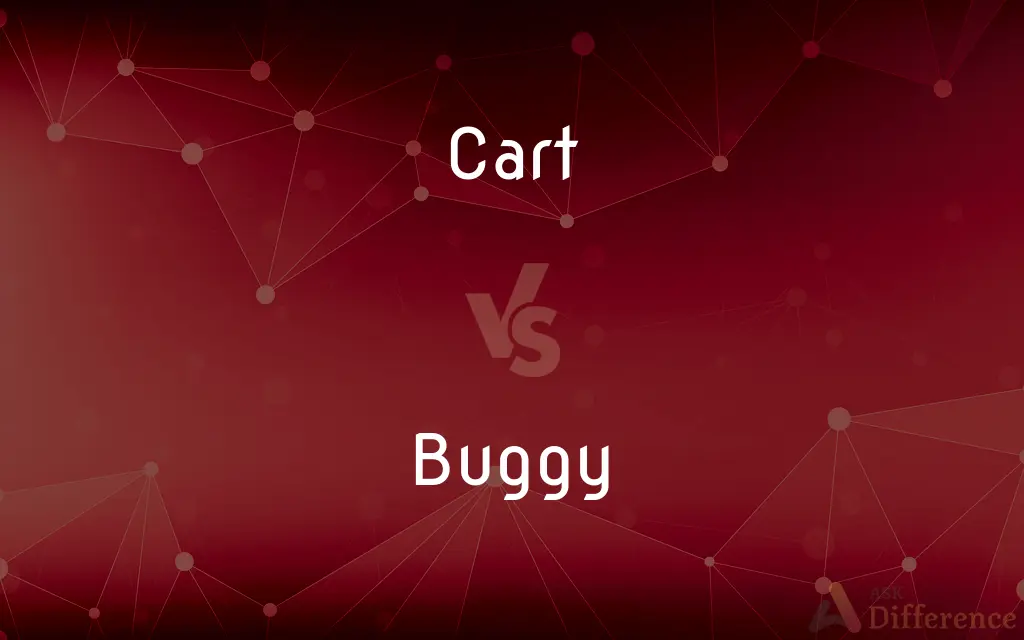Cart vs. Buggy — What's the Difference?
By Maham Liaqat & Fiza Rafique — Updated on April 3, 2024
Carts are versatile, wheeled vehicles typically pushed or pulled for transporting goods, whereas buggies are smaller, often horse-drawn, for carrying people.

Difference Between Cart and Buggy
Table of Contents
ADVERTISEMENT
Key Differences
Carts are utilitarian vehicles with one or more wheels, designed for the transportation of goods or materials. They can be manually operated, pushed, or pulled, and are found in various settings like gardens, factories, and stores. Buggies, on the other hand, are lightweight, often horse-drawn vehicles with two or four wheels, primarily intended for carrying people rather than goods. They have historical significance and are still used in certain communities for transport.
While carts are valued for their simplicity and practicality in transporting heavy loads over short distances, buggies serve a different purpose, focusing on passenger comfort and mobility. The design of buggies is more complex, often featuring suspension systems and seating arrangements, whereas carts are more straightforward, emphasizing functionality and capacity.
In terms of construction, carts are generally made to be sturdy and durable, using materials like metal and wood, suitable for carrying loads. Buggies, however, might incorporate lighter materials and intricate designs to accommodate passengers, reflecting their use in leisurely rides or specific cultural contexts.
The usage context of carts spans a wide range, from industrial applications to personal gardening and shopping assistance. Buggies, conversely, have a more niche application today, largely seen in recreational settings, historical reenactments, or communities that eschew modern vehicles.
Technological advancements have led to the development of motorized carts, such as golf carts and utility carts, expanding their functionality beyond manual labor. Buggies have also evolved but remain closely associated with their traditional, horse-drawn form, symbolizing a simpler way of life or serving as a cultural artifact.
ADVERTISEMENT
Comparison Chart
Primary Use
Transporting goods
Carrying people
Operation
Pushed or pulled by hand; some motorized versions
Often horse-drawn; some motorized versions
Construction Materials
Metal, wood, plastic
Wood, metal, sometimes with fabric for canopies
Common Environments
Industrial, retail, personal (gardens, homes)
Recreational, historical, certain communities
Design Focus
Durability and load capacity
Passenger comfort and aesthetics
Compare with Definitions
Cart
Can be manual or motorized.
The golf cart quickly moved across the course.
Buggy
May have a motorized version in modern contexts.
Electric buggies are used to transport tourists around the resort.
Cart
Essential in various industries for logistics.
In the factory, carts are used to transport materials between departments.
Buggy
A light, horse-drawn carriage for people.
They took a buggy ride through the park for their anniversary.
Cart
Varies widely in size and design.
The shopping cart was filled to the brim with groceries.
Buggy
Features seating and sometimes a canopy.
The buggy had a red canopy to protect from the sun.
Cart
Offers practicality and efficiency in material handling.
Using a garden cart makes yard work much easier.
Buggy
Often used for leisure or in specific communities.
Amish communities commonly use buggies for transportation.
Cart
A wheeled vehicle for transporting goods.
He used a cart to move the boxes into the warehouse.
Buggy
Represents a bygone era or traditional lifestyle.
Historical tours in the city often include a buggy ride.
Cart
A light motorized vehicle
A golf cart.
Buggy
A small motor vehicle, typically with an open top
A golf buggy
Cart
A cart or dray (Aus. & NZ) is a vehicle designed for transport, using two wheels and normally pulled by one or a pair of draught animals.
Buggy
A light folding chair on wheels, in which a baby or young child can be pushed along
Her two younger children were in a buggy
Cart
A small wheeled vehicle typically pushed by hand
A shopping cart.
A pastry cart.
Buggy
Infested with bugs.
Cart
A two-wheeled vehicle drawn by an animal and used in farm work and for transporting goods.
Buggy
(of a computer program or system) faulty in operation.
Cart
The quantity that a cart can hold.
Buggy
Mad; insane.
Cart
An open two-wheeled carriage.
Buggy
A small, light, one-horse carriage usually having four wheels in the United States and two wheels in Great Britain.
Cart
To convey in a cart or truck
Cart away garbage.
Buggy
A baby carriage.
Cart
To convey laboriously or unceremoniously; lug
Carted the whole gang off to jail.
Buggy
A passenger or recreational vehicle, usually with oversized tires, designed for off-road use.
Cart
A small, open, wheeled vehicle, drawn or pushed by a person or animal, more often used for transporting goods than passengers.
The grocer delivered his goods by cart.
Buggy
(Informal) An automobile.
Cart
A small motor vehicle resembling a car; a go-cart.
Buggy
Chiefly Southern US A shopping cart, especially for groceries.
Cart
(Internet) A shopping cart.
Buggy
Infested with bugs.
Cart
A tape cartridge used for pre-recorded material such as jingles and advertisements.
Buggy
(Computers) Having many software bugs
A buggy program.
Cart
A cartridge for a video game system.
My Final Fantasy cart on the NES is still alive and kicking.
Buggy
(Slang) Crazy.
Cart
(transitive) To carry or convey in a cart.
Buggy
A small horse-drawn cart.
Cart
To carry goods.
I've been carting these things around all day.
Buggy
A small motor vehicle, such as a dune buggy.
Cart
(transitive) To remove, especially involuntarily or for disposal.
Buggy
A hearse.
Cart
To expose in a cart by way of punishment.
Buggy
A pushchair; a stroller.
Cart
A common name for various kinds of vehicles, as a Scythian dwelling on wheels, or a chariot.
Buggy
A shopping cart or trolley.
Cart
A two-wheeled vehicle for the ordinary purposes of husbandry, or for transporting bulky and heavy articles.
Packing all his goods in one poor cart.
Buggy
With insects.
Cart
A light business wagon used by bakers, grocerymen, butchers, etc.
Buggy
(computing) Containing programming errors.
This software is so buggy that I don't know how anyone can use it!
Cart
An open two-wheeled pleasure carriage.
Buggy
Resembling an insect.
Cart
To carry or convey in a cart.
Buggy
(slang) crazy; bughouse.
Cart
To expose in a cart by way of punishment.
She chuckled when a bawd was carted.
Buggy
Infested or abounding with bugs.
Cart
To carry burdens in a cart; to follow the business of a carter.
Buggy
A light one horse two-wheeled vehicle.
Villebeck prevailed upon Flora to drive with him to the race in a buggy.
Cart
A heavy open wagon usually having two wheels and drawn by an animal
Buggy
A light, four-wheeled vehicle, usually with one seat, and with or without a calash top.
Cart
Wheeled vehicle that can be pushed by a person; may have one or two or four wheels;
He used a handcart to carry the rocks away
Their pushcart was piled high with groceries
Buggy
A small lightweight carriage; drawn by a single horse
Cart
Draw slowly or heavily;
Haul stones
Haul nets
Buggy
Informal or slang terms for mentally irregular;
It used to drive my husband balmy
Cart
Transport something in a cart
Buggy
Infested with bugs
Common Curiosities
Can buggies be motorized?
Yes, there are motorized versions of buggies, often used in recreational or tourism settings.
Why are buggies still used today?
Buggies are used for leisure, tourism, historical reenactment, or by communities that prefer traditional modes of transportation.
What materials are carts made of?
Carts can be made from metal, wood, or plastic, depending on their intended use and durability requirements.
What is the main purpose of a cart?
A cart is primarily used for transporting goods, ranging from small personal items to large industrial materials.
What is a common use for buggies in modern times?
Buggies are commonly used for leisurely rides, in tourism, or by communities like the Amish for everyday transportation.
What types of carts are there?
There are many types of carts, including shopping carts, hand carts, garden carts, and industrial carts, each designed for specific tasks.
Why might someone choose a buggy ride today?
Someone might choose a buggy ride for a leisurely, nostalgic experience or to appreciate a simpler, slower pace of life.
Are carts considered vehicles?
Yes, carts are considered vehicles, especially those designed for specific tasks like transportation of goods.
What is the significance of buggies in historical contexts?
Buggies are significant in historical contexts as a mode of personal transportation before the advent of automobiles, reflecting cultural and technological periods.
How is a buggy different from a cart?
A buggy is a vehicle designed for carrying people, often horse-drawn, focusing on passenger comfort rather than goods transport.
Can carts be used for transporting people?
While some carts, like pedicabs, are designed for transporting people, most carts are intended for goods.
Do all buggies have a canopy?
Not all buggies have canopies, but many are equipped with them for passenger comfort and protection from the elements.
How does the design of a cart reflect its use?
The design of a cart, focusing on durability and capacity, directly supports its primary function of transporting goods efficiently.
Are there any legal restrictions on using buggies?
In some areas, there are legal restrictions or specific regulations for using buggies on public roads, especially for horse-drawn types.
How have carts evolved with technology?
Carts have evolved to include motorized versions like golf carts and utility carts, expanding their use beyond manual labor.
Share Your Discovery

Previous Comparison
Intention vs. Intension
Next Comparison
Stroma vs. StomataAuthor Spotlight
Written by
Maham LiaqatCo-written by
Fiza RafiqueFiza Rafique is a skilled content writer at AskDifference.com, where she meticulously refines and enhances written pieces. Drawing from her vast editorial expertise, Fiza ensures clarity, accuracy, and precision in every article. Passionate about language, she continually seeks to elevate the quality of content for readers worldwide.














































